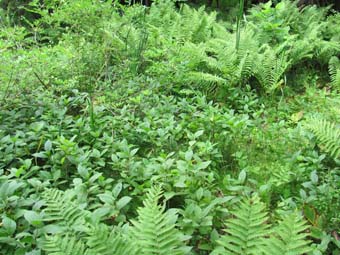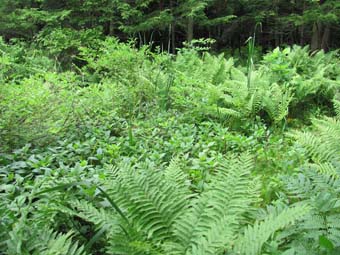Alder-leaved Buckthorn – Inland Sedge – Golden Ragwort Shrub Fen
System: Palustrine
Subsystem: Shrubland
PA Ecological Group(s): Peatland Wetland
Global Rank:GNR
![]() rank interpretation
rank interpretation
State Rank: S1
 - golden ragwort fen05_WattsburgFen.jpg)
General Description
In Pennsylvania, this community type is most characteristic of the northwestern glaciated section, although it may occur elsewhere. These are wetlands that have developed under the influence of base-rich water, and usually have a substantial organic layer. The pH of surface water during the growing season ranges from 6.9 to 7.9. Structurally, they are dominated by a mixture of shrubs and herbaceous plants (predominantly sedges). Most sites have an area in the wettest portion that is without woody growth. Also, within the wetland complex, there are frequently areas of visible surface flow (seeps). Characteristic shrubs include alder-leaved buckthorn (Rhamnus alnifolia), willows (Salix spp.), velvetleaf blueberry (Vaccinium myrtilloides), dwarf raspberry (Rubus pubescens), highbush blueberry (Vaccinium corymbosum), speckled alder (Alnus incana ssp. rugosa), arrow-wood (Viburnum recognitum), and red-osier dogwood (Cornus sericea). The herbaceous species vary; some typical representatives are golden ragwort (Packera aurea), water avens (Geum rivale), rough-leaved goldenrod (Solidago patula ssp. patula), boneset (Eupatorium perfoliatum), field horsetail (Equisetum arvense), fowl mannagrass (Glyceria striata), sedge (Carex interior), many-fruited sedge (Carex lasiocarpa), sedge (Carex hystericina), turtlehead (Chelone glabra), marsh fern (Thelypteris palustris), skunk-cabbage (Symplocarpus foetidus), sedge (Carex lacustris), and common cat-tail (Typha latifolia). Some sites may contain calciphilic species such as golden-fruited sedge (Carex aurea), yellow sedge (Carex flava), prairie sedge (Carex prairea), Atlantic sedge (Carex sterilis), sedge (Carex tetanica), thin-leaved cotton-grass (Eriophorum viridicarinatum), spike muhly (Muhlenbergia glomerata), and grass-of-Parnassus (Parnassia glauca). Characteristic bryophytes include Campylium stellatum, Plagiomnium ellipticum, Sphagnum palustre, Bryum pseudotriquetrum, and Climaceum americanum. On many of these sites, microtopography and vegetation response creates a tight mosaic of locally different chemical conditions. Hummocks of mosses, especially Sphagnum spp., form at the base of shrubs and stumps and lower the pH in their immediate surroundings. This provides a suitable habitat for acid-loving species like blueberries (Vaccinium spp.), bluebead and speckled wood lilies (Clintonia spp.), teaberry (Gaultheria procumbens), and Eastern hemlock (Tsuga canadensis).
Rank Justification
Critically imperiled in the jurisdiction because of extreme rarity or because of some factor(s) such as very steep declines making it especially vulnerable to extirpation
Identification
- Dominated by alder-leaved buckthorn (Rhamnus alnifolia), sedge (Carex interior), many-fruited sedge (Carex lasiocarpa), sedge (Carex hystericina), and sedge (Carex lacustris)
- Occurs in western Pennsylvania
- Calcareous soils
Shrubs
- Dwarf blackberry (Rubus pubescens)
- Highbush blueberry (Vaccinium corymbosum)
- Speckled alder (Alnus incana ssp. rugosa)
- Northern arrow-wood (Viburnum recognitum)
- Red-osier dogwood (Cornus sericea)
- Alder-leaved buckthorn (Rhamnus alnifolia)
- Willows (Salix spp.)
- Sour-top blueberry (Vaccinium myrtilloides)
Herbs
- Golden ragwort (Packera aurea)
- Water avens (Geum rivale)
- Spreading goldenrod (Solidago patula ssp. patula)
- Boneset (Eupatorium perfoliatum)
- Field horsetail (Equisetum arvense)
- Fowl mannagrass (Glyceria striata)
- Sedge (Carex interior)
- Many-fruited sedge (Carex lasiocarpa)
- Sedge (Carex hystericina)
- Turtlehead (Chelone glabra)
- Marsh fern (Thelypteris palustris)
- Skunk cabbage (Symplocarpus foetidus)
- Sedge (Carex lacustris)
- Common cat-tail (Typha latifolia)
- Golden-fruited sedge (Carex aurea)
- Yellow sedge (Carex flava)
- Prairie sedge (Carex prairea)
- Atlantic sedge (Carex sterilis)
- Wood's sedge (Carex tetanica)
- Thin-leaved cotton-grass (Eriophorum viridicarinatum)
- Spike muhly (Muhlenbergia glomerata)
- Grass-of-parnassus (Parnassia glauca)
Bryophytes
* limited to sites with higher soil calcium
Vascular plant nomenclature follows Rhoads and Block (2007). Bryophyte nomenclature follows Crum and Anderson (1981).
International Vegetation Classification Associations:
USNVC Crosswalk:None
Representative Community Types:
Western Allegheny Tall Shrub Rich Fen (CEGL005088)
NatureServe Ecological Systems:
None
NatureServe Group Level:
None
Origin of Concept
Fike, J. 1999. Terrestrial and palustrine plant communities of Pennsylvania. Pennsylvania Natural Diversity Inventory. Pennsylvania Department of Conservation and Recreation, Bureau of Forestry, Harrisburg, PA. 86 pp.
Pennsylvania Community Code*
ST : Buckthorn – Sedge (Carex Interior) – Golden Ragwort Fen
*(DCNR 1999, Stone 2006)
Similar Ecological Communities
The presence of heaths in these systems may at first be confusing, but a closer look should reveal a number of calciphilic species. Calciphiles that may occur include golden-fruited sedge (Carex aurea), yellow sedge (Carex flava), prairie sedge (Carex prairea), Atlantic sedge (Carex sterilis), sedge (Carex tetanica), thin-leaved cotton-grass (Eriophorum viridicarinatum), spike muhly (Muhlenbergia glomerata), and grass-of-Parnassus (Parnassia glauca). The presence of these calciphiles separates this community from Hemlock Palustrine Forest, Hemlock – mixed hardwood palustrine forest, Highbush Blueberry – Sphagnum Wetland, and Acidic Mixed Shrub – Sphagnum Wetland community types which may be in close proximity to this type.
Fike Crosswalk
Buckthorn - sedge (Carex interior) - golden ragwort fen
Conservation Value
Alder-leaved Buckthorn – Inland Sedge – Golden Ragwort Shrub Fen is a rare community in the state and may include rare plant species such as golden-fruited sedge (Carex aurea), yellow sedge (Carex flava), Atlantic sedge (Carex sterilis), sedge (Carex tetanica), spike muhly (Muhlenbergia glomerata), and grass-of-Parnassus (Parnassia glauca).
Threats
The greatest threats to Alder-leaved Buckthorn – Inland Sedge – Golden Ragwort Shrub Fen communities are disruptions to bedrock or glacial deposits such as drilling or mining in nearby areas and groundwater extraction, which can contaminate or alter the flow patterns of the groundwater that feeds the seepage. Groundwater pollution can also occur from improperly installed septic systems, from improperly lined underground waste disposal, and in agricultural areas from infiltration of pesticides, fertilizer, and bacteria from animal wastes. Invasive plant species can threaten the biological integrity of the community. Wetland soils and vegetation are sensitive and will be damaged by foot traffic or recreational vehicles as they are easily compacted.
Management
Drilling, mining, or other disruptions to bedrock or glacial deposits should not be undertaken within half a mile of a seepage wetland without a thorough understanding of bedrock layers and groundwater flows. Groundwater flow patterns do not always mirror surface watersheds, and in some cases aquifers may be contiguous over large areas. Seepage wetlands are also sensitive to trampling and other physical disturbance from recreational activities; trails should be sited away from the wetland, or elevated structures employed to prevent traffic in the wetland. These wetlands may require periodic disturbance such as burning or grazing to maintain their open canopy which is indicative of this community and the rare species that occupy the community.
A natural buffer around the wetland should be maintained in order to minimize nutrient runoff, pollution, and sedimentation. The potential for soil erosion based on soil texture, condition of the adjacent vegetation (mature forests vs. clearcuts), and the topography of the surrounding area (i.e., degree of slope) should be considered when establishing buffers. The buffer size should be increased if soils are erodible, adjacent vegetation has been logged, and the topography is steep as such factors could contribute to increased sedimentation and nutrient pollution. Direct impacts and habitat alteration should be avoided (e.g., roads, trails, filling of wetland) and low impact alternatives (e.g., elevated footpaths, boardwalks, bridges) should be utilized in situations where accessing the wetland cannot be avoided. Care should also be taken to control and prevent the spread of invasive species within the wetland. Alterations to groundwater sources should be minimized.
Research Needs
More site inventory and classification work is needed to refine the definition of this community type and resolve its relationship to other types. It appears that some of these wetlands will succeed to shrubland if not maintained. Management of these wetlands would be informed by an understanding of natural successional pathways, and of the historical frequency of disturbances such as fire and grazing in these wetlands.
Trends
Specific information on the loss and degradation of this community is not available. However, most calcareous soils in Pennsylvania occur in valleys or glaciated regions that are also favorable for agriculture and settlement, and have been extensively cleared of natural vegetation for these purposes. This community type is likely to have been lost or altered at a disproportionately high rate to other wetland type
Range Map

Pennsylvania Range
NW Pennsylvania
Global Distribution
Unknown
Pennsylvania Department of Conservation and Natural Resources (DCNR). 1999. Inventory Manual of Procedure. For the Fourth State Forest Management Plan. Pennsylvania Bureau of Forestry, Division of Forest Advisory Service. Harrisburg, PA. 51 ppg.
Stone, B., D. Gustafson, and B. Jones. 2006 (revised). Manual of Procedure for State Game Land Cover Typing. Commonwealth of Pennsylvania Game Commission, Bureau of Wildlife Habitat Management, Forest Inventory and Analysis Section, Forestry Division. Harrisburg, PA. 79 ppg.
Cite as:
Podniesinski 2022. Pennsylvania Natural Heritage Program. Alder-leaved Buckthorn – Inland Sedge – Golden Ragwort Shrub Fen Factsheet. Available from: https://www.naturalheritage.state.pa.us/Community.aspx?=30002 Date Accessed: January 13, 2026

 - golden ragwort fen05_WattsburgFen.jpg)
 - golden ragwort fen01.jpg)
 - golden ragwort fen02.jpg)
 - golden ragwort fen03.jpg)
 - golden ragwort fen04.jpg)
 - golden ragwort fen06.jpg)
 - golden ragwort fen07.jpg)
 - golden ragwort fen08.jpg)
 - golden ragwort fen09LowvilleFen.jpg)







